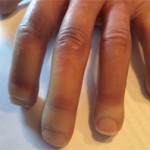“Can you get me the beeper number of the resident? From our perspective, we need to push the captopril quickly up to whatever dose normalizes her BP, otherwise her kidneys are going to shut down. Has her blood pressure been running this high all day?” I asked.
“No, but creeping pretty steadily upward. So have her O2 needs. What’s going on there?”
“We think the scleroderma is involving the lungs.”
“Doesn’t she need a diuretic? She has crackles in both bases,” her nurse asked.
“No. The oxygenation won’t respond to that. It’s not like heart failure.”
At that moment, Dr. Medsger strode through the door and peeked through the curtain at Dr. Indura. He took one look at the monitor, turned on his heels and crossed his arms, “Dr. Radis, what’s going on with her captopril?”
“First dose an hour ago, 25 mg.” I knew this was not the answer he wanted to hear.
“That’s unacceptable. Have you called the primary service?” The ICU nurse quietly dialed the medicine service resident’s pager. A minute later I was on the phone with the resident and making our case for more aggressive management of Dr. Indura’s hypertension.
When I looked up, Dr. Medsger was sitting on the edge of Dr. Indura’s bed. The pharmacy drawer was open; he held the next dose of captopril in the palm of his hand.
“Dr. Indura, I want you to take an additional dose of the blood pressure medication captopril. Take your time. Here, why don’t you sit on the edge of the bed? Let’s make sure it goes all the way down. Dr. Radis, can you get us a cup of water?” He waited a minute as she swallowed the pill and brushed her hair back from her face with the back of her hand.
“Based on today’s blood work, we believe you have what we call scleroderma renal crisis. Captopril is the drug of choice for scleroderma hypertension, and we’ll be titrating up the dose until your blood pressure normalizes.” He paused and held her forearm lightly. “Your kidneys have already taken a significant hit.”
“And I’m sorry, but there’s more bad news.” He pulled out her chest X-ray from a folder and hung it on the view box on the far wall. “These patchy white areas are likely triggered by your scleroderma. I’ve consulted one of our pulmonary specialists. It may require a bronchoscopy, a test where they pass a flexible tube into your windpipe to biopsy the lung. We may need to start a medication called cyclophosphamide to treat the lung.



